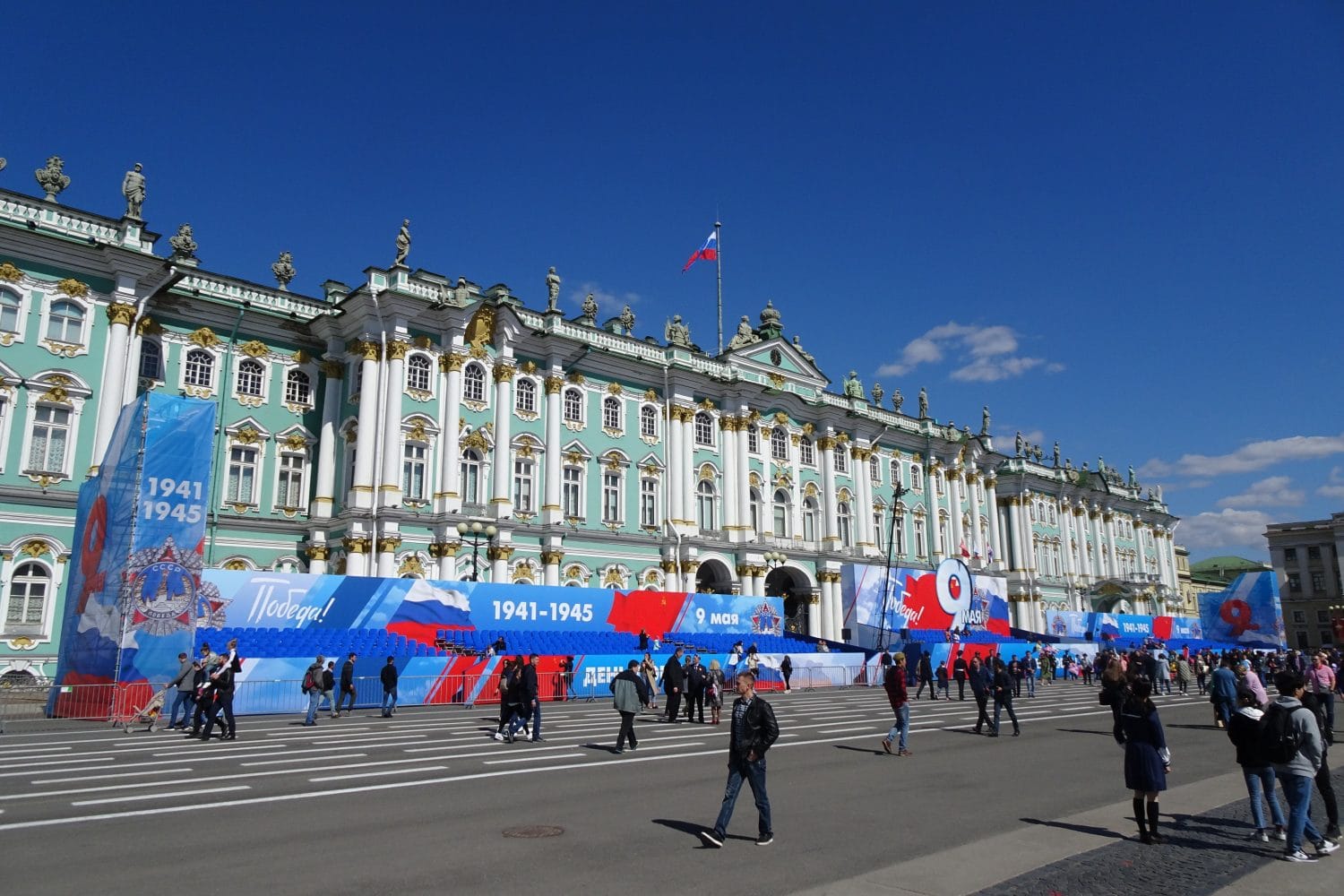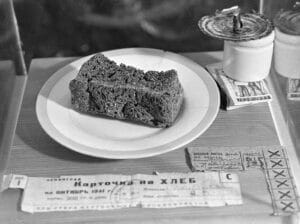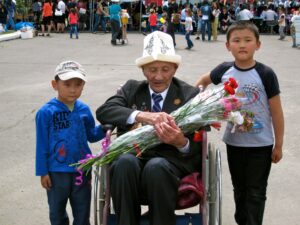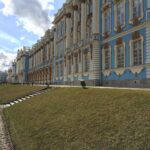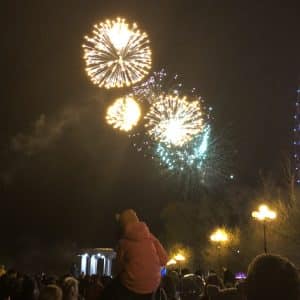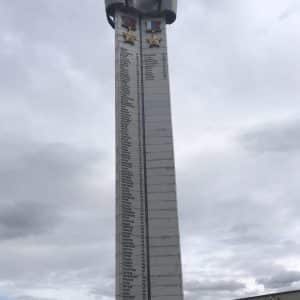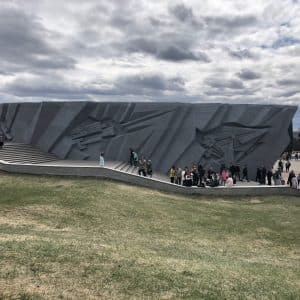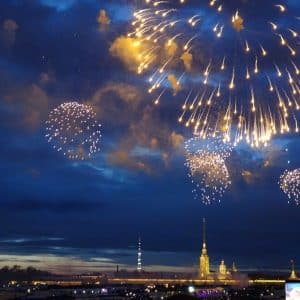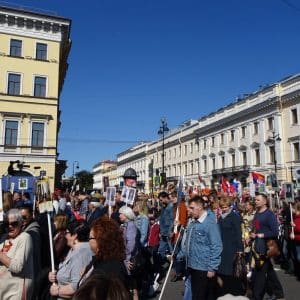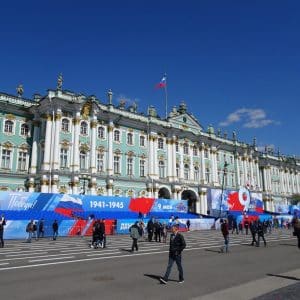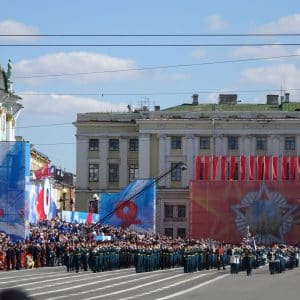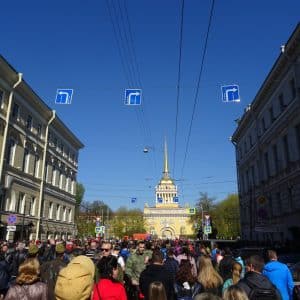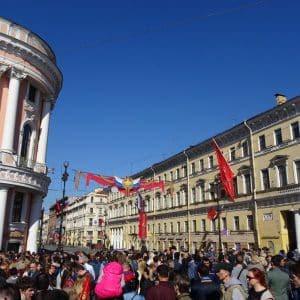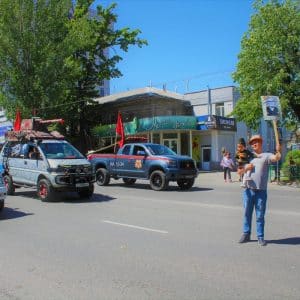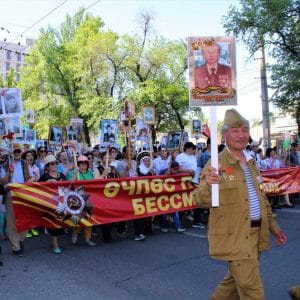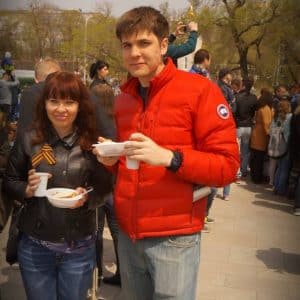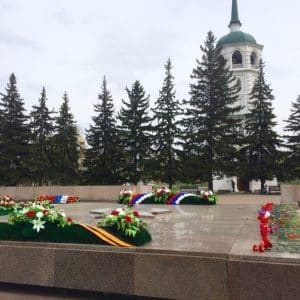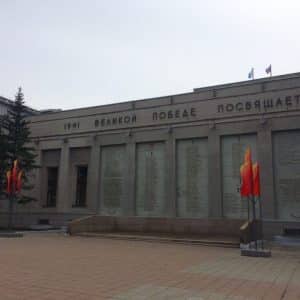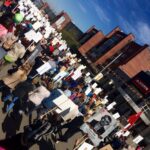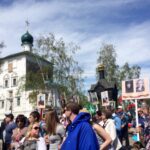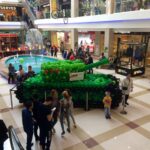World War II holds profound significance in modern Russian culture, transcending mere historical events to become a deeply ingrained element of national identity and collective memory. Known as the Great Patriotic War in Russia, it represents a pivotal period of sacrifice, resilience, and victory against Nazi Germany, shaping the ethos of the nation. Victory Day, which celebrates the end of WWII, is still one of Russia’s biggest holidays. War movies play almost endlessly on TV, military parades are held, and historical reenactments are played out such as with soldiers in period uniforms handing out portions of boiled buckwheat from portable military kitchens.
Keeping the memory of the war alive seems to be a major prerogative of the Russian state as well as its people. This can be seen in modern literature, art, politics, and public commemorations. Moreover, the Soviet victory in World War II remains a cornerstone of Russian geopolitical narratives, influencing contemporary perceptions of Russia’s role on the global stage.
Below are commentaries from SRAS students studying abroad who witnessed Victory Day celebrations or other WWII commemorations.
Remembrance of WWII in St. Petersburg, 2019
By Lucine Poturyan
Visiting Russia for the first time, and studying abroad there as an American student were striking experiences for me. The sights, immersion into a new culture, and Russian language were fundamental parts of my study abroad experience. I was surprised, however, as to the important role that history played in the backdrop of the Russian experience. Though I was only there for a short while, I got a taste of how history, and specifically, World War II, has come to shape the modern Russian identity.
In the U.S., I was taught about the sheer number of WWII Soviet casualties with what now seems like an air of informality; I never really comprehended how many lives were lost. In Russia, I was able see and hear a local perspective on the catastrophic deaths of 27,000,000 soldiers and civilians – some 16% of the population – all while millions of eventual survivors suffered hunger, pain, and loss. This trauma of war was understandably absorbed into the culture and identity of the Russian people.
I learned that World War II was more than a loss of lives to the Russians. Visiting the Leningrad siege memorial, I was immersed into the chilling atmosphere created by the historical documents and artifacts from the war. The descent into the memorial’s museum was dark, with rocket shells lining the walls. Inside, more shells lined the walls of the whole museum. The implied violence and the somber quality of the wide, dark room forces one to think about the chilling and grotesque historical event that was the siege of Leningrad. A video played on one of the walls, depicting the city during its nearly 900 days of turmoil. Handwritten accounts from children, soldier’s radios, and household items such as typewriters, laundry items, and notebooks that were hard to obtain during the war filled the inside of the museum. The items were encapsulated in their cold, glass cases, yet I found it hard to separate myself from the reality that lay before me. Our tour guide translated some of the Russian decals describing people and events, and his narration of the events of the siege and description of the resilience of the Soviet citizens painted a picture of pain, loss, and triumph during the war.
I was also able to hear personal history from one of my Russian history professors at the St. Petersburg State University of Economics. She described losing both of her grandfathers to the war, and growing up with a strong matriarchal presence in her family. She also described how nearly an entire generation of young men were simply gone after the war and the widespread affects this had on society, namely the need for women to mobilize in taking on the roles that men had traditionally worked. She put it succinctly: “Still, after the war, there are few, if any, families in St. Petersburg that haven’t been affected by it.”
The memory of those lost to the war has not left the Russian consciousness, as evidenced from the countless memorials and statues and even mass graves that I could see as explored St. Petersburg, Moscow, and Novgorod. These are still constantly showered with flowers in dedication to those taken by the war in the three of the aforementioned cities. From my history class, I learned about the yearly efforts to search for more soldier’s bodies in swamps, fields, lakes and ponds. New finds are reported on TV news. I got to see the fierce celebration of Victory Day, as well as the yearly walk of the Immortal Regime, in which family members of those who died march with photographs and flowers commemorating their loved ones. Even being here for a short time, one cannot miss power the events of WWII still have over daily Russian life.
I learned how the weight of the war brought forth the perseverance and the courage of the people of the Soviet Union. Russians still revere this perseverance and hold it up as something that Russians should aspire to and as something that makes Russians Russian. While under the Siege of Leningrad, for instance, embattled citizens created, performed, and attended Shostakovich’s Seventh Symphony. They made a communal effort to keep streets clean of deceased bodies. They put their lives at risk to bring aid across nearby Lake Ladoga.
When Russians think of WWII, they think of responsibility in the face of tremendous brutality and overcoming that brutality and salvaging their freedom. Another important aspect of the war for the Soviets that was never in my history classes in the US was that the Soviets were fighting to prevent the genocide of their people and the colonization of their country. The stakes for the USSR were huge, much larger and more immediate than they were for their American allies.
It is true that the Soviet Union’s participation in the war, and the Cold War thereafter, was depicted as a struggle against a world-wide enemy, with the goal of spreading communism once that goal is accomplished. However, Americans should understand that World War II was, for the Soviets, a struggle against a force that would have absorbed and exterminated them. The Soviets were fighting for their lives and liberty, they were relying on perseverance and self-reliance to do so. These are all ideas that parallel those that form the basis of American identity. We fought WWII together. While the Russian memory of the war is much stronger than the American, the reasons for this are quite evident and understandable: the Soviets fought on their own soil and the whole population experienced the full and immediate horror of war together. Understanding this, as well as how the values reflected in these different cultures are, in fact, shared between us, should be able to bring the U.S. and Russia closer together.
While these things seem obvious to me know, I’m not sure that I would have learned them without actually having physically crossed the geographic and cultural distance that separates the US and Russia. I’m grateful for my study abroad experience, however short it was, and what it taught me about Russia, history, identity, and how cultures that seem so different can understand each other and show compassion to each other when given the chance to meet face to face.
Remembrance of WWII in St. Petersburg, 2016
By Erik Finn
Throughout my program in Russia these past few months, the toll of the Second World War, has often been present and palpable. During World War II and the Great Fatherland War, the name Russians give the part of the war that took part on Soviet land, approximately 20-30 million Soviet men and women perished. Some died in battle, while trying to defend the Fatherland from the Nazi blitzkrieg that began in June of 1941. Others succumbed to starvation or other secondary effects of war, as was the case in my city of study, St. Petersburg (formerly Leningrad). One third of the city’s then-three million citizens died as a result the Nazi blockade, which cut off supply lines for nearly 900 days (Dykman). Though I had heard the startling statistics before coming to Russia, it was hard to conceptualize the reality of these numbers through history books or documentaries that I had previously turned to for information. Now in St. Petersburg for four months, the personal and individual effect of the war has become clear.

It warns, “Citizens! During shelling this side of the street is most dangerous.”
Citizens of St. Petersburg continue to leave flowers by the sign.
Perhaps the most immediate sign of the war for me were the buildings in St. Petersburg. On a bus tour during the first week of the semester, the guide regaled us with grand architectural descriptions of the many building ensembles in the northern capital. A large portion of her narrative concerned post-war renovation and restoration. A Nazi missile fell through the roof of the Winter Palace and into the grand ballroom. Artillery had chipped away at the columns of the iconic St. Isaacs Cathedral despite the efforts to camouflage its golden dome with gray paint. This theme of damage and restoration continued throughout the tour and on other palace and building tours during the semester. Each visit often featured photos from the blockade and views of destruction that followed air raids. At Catherine’s Palace in Pushkin, our group was astonished by the incredible opulence of the present day palace against photos showing the destruction that followed a fire set by the Nazis.
On a long walking tour of the city, our guide showed us a monument along the Fontanka river embankment, which memorialized the people of Leningrad that had used the river’s water to drink and wash clothes during the blockade. He then added the anecdote of his aunts, who had survived the siege. He told of their frailness and thinness, which served as reminders of the psychological and physical result of severe food shortages during that time.
The familial accounts of the war continued with a story from my Russian language teacher one day during class. Like most Russians, the war had taken members of her family. Her great-uncle, 17 at the time, lied about his age in order to fight for the fatherland. Tragically, he died within the first few days of fighting in Stalingrad. Along with these second hand accounts, I was privileged to speak with a 75-year-old Russian grandmother, who I had been meeting with for language practice. Valentina grew up in a small town in Siberia and was born at the beginning of the war in 1941. Her generation, now called “deti voyni” or children of the war, were too young to remember the actual happenings of the conflict but were deeply affected by its results. Her father and older brother perished in the conflict and she recalled a very sad childhood. Valentina recalled there being very few men left in her town and that women in the community often cried. Although the stories I’ve heard only account for a few of the countless victims of the War, they were invaluable to my growing conception.
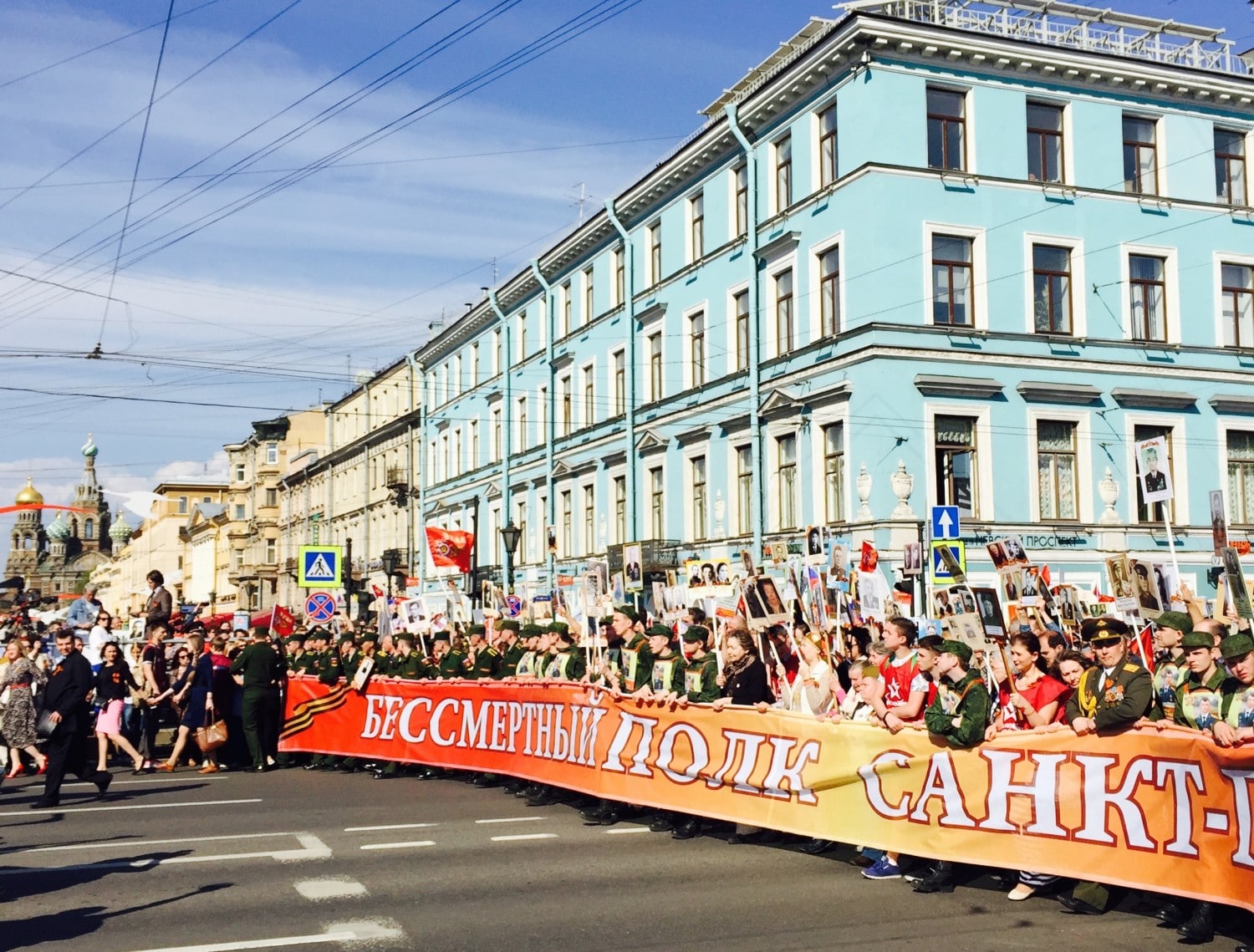
With the context of stories and history, aspects of daily life in St. Petersburg had more meaning. The great respect for the elderly on public transportation and on the street, were predicated by deep respect for the sacrifices made for the fatherland. The many memorials throughout the city and country, always adorned with fresh roses, reflected the common mantra, “No one is forgotten, and nothing is forgotten.” The somber yet grand spectacle on May 9, Day of Victory, in which young and old came together, conveyed the communality and eternality of remembrance.
The toll of war on the Soviet Union is important to understand in considering its continued effect on the modern Russian people. Consciousness and ethos are greatly affected by these types of devastating historical events, especially those in such great magnitude as the Second World War. I know my discoveries over the past few months are an invaluable resource as I continue to study the complexities of Russia and its people.
Dykman, JT. “WWII Soviet Experience.” Eisenhower Institute at Gettysburg College –. Eisenhower Institute, n.d.
Victory Day – 4 Questions Answered by Students Abroad 2016-2019
Victory Day is celebrated every May 9th in many countries across the former Soviet space. This public holiday gives often multiple days off and celebrates the end of The Great Patriotic War (which is WWII as experienced in the USSR). Millions died in the war from causes ranging from combat to starvation; very few families were left unaffected by the hardship and loss. Understandably, many in the former Soviet space take this day quite seriously.
We asked some of students on SRAS programs abroad to report on what they observed of the commemoration of Victory Day in their locations.
Where did you go to experience the holiday?
Morgan Henson (Khabarovsk, 2019): I left my study abroad program’s home base of Vladivostok and travelled North to the city of Khabarovsk. I arrived right as the parade was beginning, so I missed the first half, but when I eventually arrived to the city center, everything was bustling with people, food, events, music, and much more. On the boardwalk, there was an amusement park that had games and rides for all ages, old military tanks in the center that young children were playing on like a jungle gym, and everyone was decorated with the orange and black ribbons and banners that read “День Победы” (“Victory Day” in Russian).
In the parade, people were holding makeshift picket signs with old photos of Soviet soldiers on them. When asked, the locals described it as a tribute to the fallen soldiers during the war. It is called the “Immortal Regiment” Parade and provides each family an opportunity to honor the people they lost in the war. Everyone marches together in a large-scale show of gratitude for their sacrifice.
At the end of the day, there was also a салют, where fireworks were set off. In Khabarovsk, the crowd gathered on the boardwalk as barges in the middle of the lake set off fireworks for the entire city to see. Although smaller than the demonstrations in Moscow, St. Petersburg, and Vladivostok, the people had pride for the fireworks and were enthusiastic all the same.
Kathryn Watt (Bishkek, 2019): I woke early on Victory Day morning and decided to go for a run to Victory Park, to check out the festivities. This park, built in commemoration of Victory Day, is located 2 miles from the London School – it’s about 40 minutes to walk, or 10 minutes by public transport. When I arrived the crowds were so big that I couldn’t get into the park, so I ran back to the London School and waited for the Immortal Regiment March that was due to start at 10am.
It was the perfect day for a parade. We (myself, another SRAS student, and the school security guard) took chairs and coffee out into the street and sat in the sunshine as the parade came by. London School was the ideal place to watch the parade, as it was right in the centre of the 6.6km route that the participants walked. First came a convoy of police cars and ambulances, blasting nostalgic Soviet music. These were followed by a regiment of soldiers carrying banners and singing at the top of their lungs – classics such as Katyusha could be heard ringing through the streets. The most amazing part of the parade was to see the crowd of locals carrying signs and banners in honor of their ancestors who fought in the war. It was completely mixed – Kyrgyz and Russian, old and young. The view ranged from Kyrgyz men in traditional hats, Russian women dressed in uniforms, and reluctant teenagers in hoodies, dragged along by their enthusiastic mothers.
Greg Tracey (St. Petersburg, 2019): I went to several places to experience the holiday. The first thing was watching the military parade held on Palace Square. I should have gone there earlier, in order to get a better spot, but as it was I gradually made my way to a decent spot near the front, on the open side of the square near the Admiralty Building. The parade included soldiers and sailors in dress uniform, military vehicles, and a military band. It was incredible to see the sheer number of people who came to watch. Many of the streets around the square were closed, and absolutely clogged with couples and families. After the parade, the police opened the square and I was able to see the viewing stand and giant “С днём победы” poster. The next thing I did was around 15:00. I went with friends to watch the Immortal Regiment March near Gostiny Dvor. This parade included trucks with survivors of the Siege of Leningrad from different districts of the city, and then anyone can fill in behind, carrying pictures of their relatives who fought and died in the Great Patriotic War (WWII). Finally, I went to see the Fireworks show in the evening. Wanting to get a good spot to watch, my friend Natasha and I went an hour early. It is a good thing we did, because thousands of people were already covering the bridge and embankments around the Neva River. We got a good spot though, and the fireworks were beautiful over the river. The Rostral columns also had their flames going at this time.
Julie Hersh (Irkutsk, 2017): This year, we had a four-day weekend for Victory Day, since it was on a Tuesday. There were concerts, rehearsals, and preliminary events starting already on Friday, and the entire city was decked out a week in advance—with banners, flags, and proclamations of victory all over the place. (I even saw a few signs that referenced the “road to Berlin.”) People in Kirov Square were handing out kolorits (колориты), orange-and-black ribbons that have come to symbolize the victory in the war. Stands in the mall were selling Soviet-Army-style hats and flags. Even the churches had Victory Day decorations.
On May 8, my group and I were lucky enough to be invited to a smaller event before the main celebrations: a memorial by the Polish community to commemorate their families’ and compatriots’ participation in the war. Echoing the main event that would take place the next day, we met at the Eternal Flame (Вечный огонь—a World War Two memorial present in most Russian cities) and walked through the main memorial, following people in traditional Polish dress. Standing in the memorial plaza, we listened to people tell the stories of their parents’ and grandparents’ experiences during the war. It was moving and solemn, not at all what I had expected of Victory Day—though a truer reminder of why the celebration actually takes place.
Jonathan Rainey (Vladivostok, 2016): The main event of the day was the parade. The streets were blocked off well in advance, and the crowds gathered early near the city square and stretching down the street. The parade commenced at 10:00 am with an introduction by one of the senior military officers in Vladivostok. It began with a presentation of the different regiments of soldiers from different branches of Russia’s armed forces, each of which yelled out the customary “Ura!” three times as they were recognized. The show got underway as the regiments marched down the street, followed by the parade of military vehicles.
Following the parade, a stage set up in the main square featured performances throughout the day of singing and dancing, remembering the war. The World War II monument in the city was also the location of plentiful activity. People gathered to lay hundreds of roses at the city’s Eternal Flame, and another location had been set up to serve Soldatskaya Kasha, or Soldier’s Cereal, to let people experience part of the common diet for soldiers during the war. This meal consisted of buckwheat cereal served with bread and black tea.
What other events were held in the area?
Morgan Henson (Khabarovsk, 2019): There were multiple events held around the city. There were concerts, dance competitions, fitness competitions – I almost joined one, but our group wanted to explore more so, unfortunately, I wasn’t able to – and much more. There were events for all ages, from sidewalk painting to taking photos on the beach: the city center was crowded with people and things to do.
Kathryn Watt (Bishkek, 2019): In the evening, the festivities continued with more music and concerts by famous Kyrgyz singers. The day ended with a firework display.
Greg Tracey (St. Petersburg, 2019): There were a couple of concerts, which I did not attend: one near Kazan Cathedral and one in Palace Square. I did not go to these because I had some studying to do for school and I am not very into concerts anyway.
Julie Hersh (Irkutsk, 2017): The main events all take place on 9 May itself, with a long program of parades, concerts, and fireworks starting at 9 a.m. I missed the early parade, because 9 a.m., but I joined some friends for the Immortal Regiment (Бессмертный полк), in which people march through the city carrying pictures of their relatives who fought or otherwise helped the war effort. It was a remarkable sight—thousands upon thousands of people (50,000, I heard) holding their signs bearing the photos, names, and birth and death dates of their veteran relatives.
Jonathan Rainey (Vladivostok, 2016): In the evening, I attended a show at the Mariinsky Theater featuring music that was written around the time of the war. It was a very last-minute decision to go for me, but I’m glad that I did. The ticket was extremely inexpensive, only 100 Rubles, and I had a fine seat. The music was excellent, with the orchestra and choir playing a selection of 15 songs such as “Katusha” and the first movement of Shostakovitch’s Symphony No. 7 “Leningrad.”
To cap the night off, the city shot off fireworks at 10:00 pm. I did not make it to see these, but I could hear them and see a few smaller displays in different parts of the city from my window.
Did you see any commercialization of this holiday?
Morgan Henson (Khabarovsk, 2019): There was a lot of commercialization for this holiday. In days before and after the holiday I traveled around Russia – Irkutsk, Novosibirsk, Vladivostok, Khabarovsk, and Birobidzhan – and saw everywhere ribbons, hats, t-shirts, stickers, bags, banners, etc. that were sold for people to show their pride and support for the holiday. Much like the Fourth of July in the United States, the commercialization was all-encompassing and multiple people waited in anticipation for the holiday.
Kathryn Watt (Bishkek, 2019): I didn’t see a great deal of commercialization in Bishkek, at least not as much as for other holidays. The one thing that most locals could be seen wearing were orange and black striped ribbons, that they wore in honour of soldiers who fought in the war. These were generally sold at supermarkets, where people could pick them up at the cashiers after doing their grocery shopping. Aside from this, flower shops sold red flowers, which people carried through the parade.
Greg Tracey (St. Petersburg, 2019): I noticed in particular that Dom Knigi was selling a lot of Victory Day-themed merchandise. Additionally, there were a lot of street vendors selling hats and flags on the street. I don’t know if this was necessarily blatant “commercialization” since people might just want those things to properly celebrate the holiday. In a similar vein, I am certain that print shops in the area do a booming trade around the holiday, as everyone prints their pictures and posters for the Immortal Regiment Parade.
Julie Hersh (Irkutsk, 2017): We saw a balloon tank attraction in a mall.
Ask locals what they think of the holiday.
Morgan Henson (Khabarovsk, 2019): When describing this holiday to my family back in the United States I said that it was a mix of the Fourth of July, Memorial Day, and Veterans Day all in one. However, the emotion associated with this holiday, mainly from the middle age and older generations, is unlike any I’ve seen in my travels. The gratitude for the soldiers who sacrificed their lives to fight against fascism and the scores of people that were sent to their deaths outnumbered any other nation. When speaking of the holiday with some of the dorm mothers before my travels, many of them began to cry as they thought about their childhoods, the people they lost, the family members who were severely affected, and the livelihoods that were lost during the war. Although only young girls at the time, the pain from those losses is clearly still felt.
Similarly, when I spoke about it during Labor Day the week before with locals, many of the locals had a strong, emotional reaction as well. In this instance, however, they asked me about my education, what I knew of the war, and how we are taught the history of the war in the United States. Before I could answer many of the questions, a lot of the locals began speaking about how the United States and the Western World are rewriting history and removing the magnitude of the Soviet Union’s sacrifice and the sheer number of bodies lost in the German invasion. They said that День Победы was the most necessary and the most important holiday in Russia because it made sure that no one ever forgot about the Soviet sacrifice and its vital role in the history of the world. This is why the locals go “all-out” for this holiday with barbeques, dressing up, and different tributes; there is a connection to the past that they believe must be reinvigorated, or it’ll be lost. I struggle to find a holiday to which we, as Americans, are this emotionally attached. It was an interesting and touching experience and I hope to return to Russia again for another День Победы celebration and be a part of the gratitude for a victory that shaped life as we know it today.
Kathryn Watt (Bishkek, 2019): There are two main ways that Bishkek locals spend the Victory Day holiday. The first is taking part in the parade and enjoying the city festivities. The second is to go out to the mountains and spend time relaxing with family and friends. The Kyrgyz people are great nature lovers and use every holiday as an opportunity to escape from city life!
Greg Tracey (St. Petersburg, 2019): Obviously most of the people that I saw, listened to, and talked with were attending the various events because that is where I saw them. I did talk to some people beforehand and afterward though that said they use the day to relax at home either alone or with family. The Immortal Regiment Parade seems like an extremely important event to many people because the city and its people suffered so much through the war.
Julie Hersh (Irkutsk, 2017): People were chanting “To victory!” and “For the motherland!” and singing Soviet and World War Two era songs. Many people, including extremely small children, were wearing Soviet Army uniforms.
Jonathan Rainey (Vladivostok, 2016): During the war, Vladivostok served as an important port for the delivery of Lend-Lease matériel from the United States to the USSR. After the American Liberty Ships delivered their cargo across the Pacific to the Russian Far East, the food, vehicles, and other important supplies were shipped overland via rail to reach the Soviet soldiers on the Eastern Front.
The Soviet Pacific Fleet, based in Vladivostok, also served in the war against the German Navy. Although most of the fleet remained in the Pacific on alert in case of action with Japan, several vessels were dispatched to the European theater to support.
But the surest sign of the war’s significance in the Russian mind came at the end of the parade. After the military’s presentation of regiments and vehicles of war, the people of the city followed. Each person or family walked down Vladivostok’s main thoroughfare carrying a sign bearing the picture and name of a relative who fought in the Great Patriotic War. The line of people walked past and grew longer and longer until it vanished from sight over the hill. Thousands participated in this moving display of respect.
Although it is generally a holiday of celebration, Victory Day also carries an attitude of somber respect. Vladivostok, which is almost as far as possible from the European theater of war in Russia still played an integral role and clearly paid a costly sum in terms of human life.
More on Holidays

Quarantine Diaries: Victory Celebrations Online
Quarantine Diaries is a series of free language lessons from SRAS. Each lesson can take a variety of forms but all focus on building intermediate and advanced vocabulary and listening skills. The below entry, from Evgenia Obryadina, SRAS’ St. Petersburg Student Coordinator focuses on video content that will be available, live, on May 9th in […]
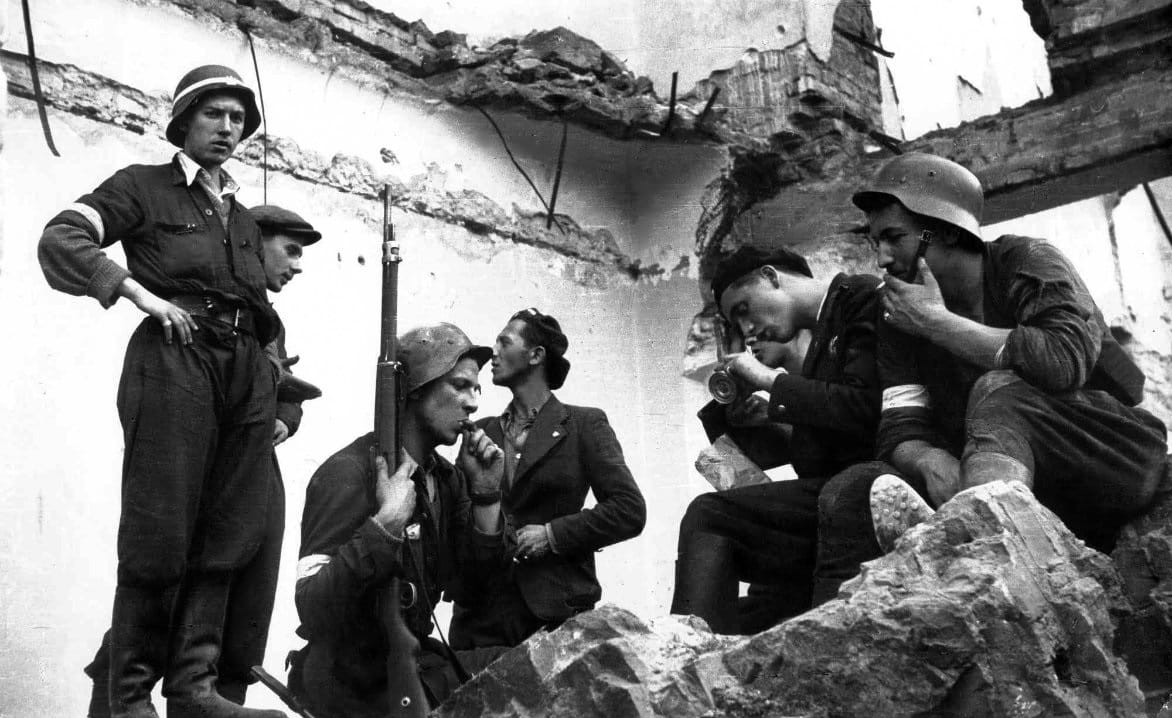
In Memory of the Warsaw Uprising
Walking around Warsaw on a daily basis, I have not become a stranger to witnessing memorials or places where something important in history has occurred. Everywhere in Warsaw it seems to be a reminder of the dark past. The oppression started on September 1st, 1939 when the German Nazis invaded Poland. The population was separated […]
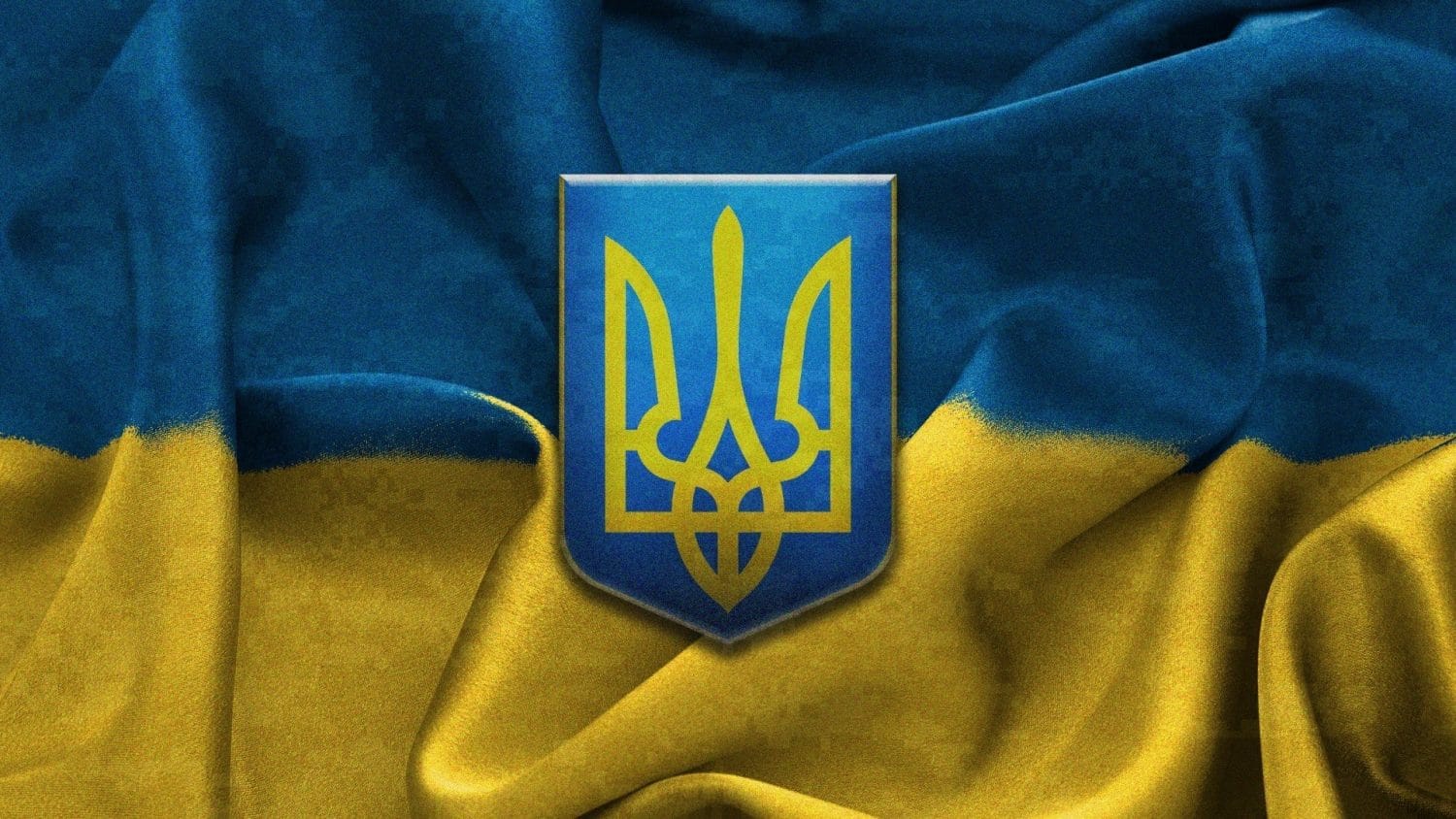
Ukraine Constitution Day: Student Observations
Constitution Day in Ukraine is celebrated on June 28th. Celebrated since 1996, this day commemorates the anniversary of the approval by the Verkhovna Rada (Ukraine’s parliament) of the Constitution of Ukraine. Before 2014 and the Revolution of Dignity in 2014, the holiday’s importance and observance were minimal and around 10% of Ukrainians believed it should […]
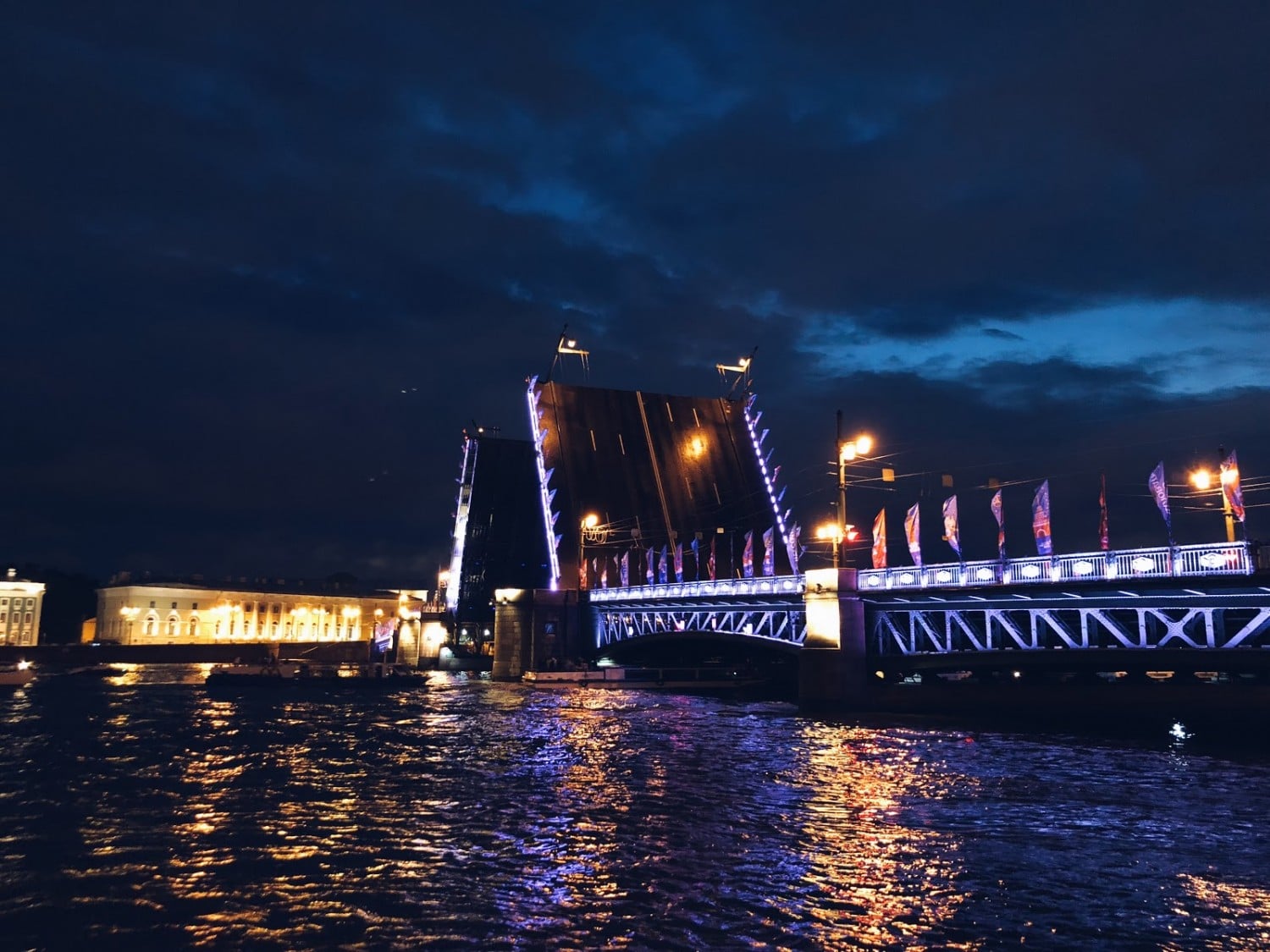
White Nights Festival: Culture and Night Life in St. Petersburg
10:17pm sunsets and 3:30am sunrises. That was my initial description of St. Petersburg when friends and family asked how my study abroad experience is going. The 18 hours of daily sunlight that mark St. Petersburg’s “White Nights” are nature’s gift to the northern city that is Russia’s cultural capital. Though the sun sets at around […]

Kyrgyz Independence Day: Student Observations
Kyrgyz Independence Day is celebrated each year on August 31. It marks the date when, in 1991, Kyrgyzstan declared itself an independent republic and left the USSR. One of my fellow classmates at my university back in America, who had studied abroad a year prior, highly recommended attending Independence Day celebrations in Kyrgyzstan, noting that, […]

